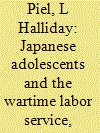| Srl | Item |
| 1 |
ID:
150576


|
|
|
|
|
| Summary/Abstract |
During the Pacific War, Japanese boys and girls were increasingly pulled out of secondary school to help the war effort as factory and farm workers. Their labor-service hours kept increasing until, by January 1944, many students were working year-long shifts. This paper argues that secondary students had a sense of entitlement to education that went against the grain of their patriotic duty to the state as shōkokumin, or ‘little countrymen’. Their later memoirs support the postwar view of their labor as child abuse. However, their identity as adolescents came more from their status as students than from their age; before 1945 most Japanese left school and entered the workforce at age 14. This paper brings together evidence that has not been linked previously: (a) the voices of student workers in diaries and memoirs; (b) the disaggregation of wartime labor by age; and (c) the differential treatment of students in the workplace.
|
|
|
|
|
|
|
|
|
|
|
|
|
|
|
|
| 2 |
ID:
166850


|
|
|
|
|
| Summary/Abstract |
During the Second World War, the Japanese state enacted sweeping education reforms designed to prime the population for Total War. The policies of the National Education Ordinance of 1941 aimed to strengthen collective loyalty and self-sacrifice for the state. Military drill and ceremonial rituals were the outward manifestation of wartime education. But this article examines how teachers borrowed an aspect of progressive ‘whole-person’ education from the more liberal pre-war era—‘daily life writing’ (seikatsu tsuzurikata)—to shape children's dispositions and consciousness. Through such reflective diary writing, children would learn to internalize the ideal behaviours and attributes of the Total War civilian. By comparing education discourse with samples of children's writings, teachers’ written feedback, and interviews of former students of an elementary school affiliated with the Ministry of Education, I show how reflective diary writing, despite its progressive origins as a means of self-expression for self-actualization and social critique, could be co-opted by right-wing Japanese ultra-nationalism for its potential as a means of self-censorship, self-monitoring, and self-control. At the same time, its practice did help children endure the hardships of war and defeat.
|
|
|
|
|
|
|
|
|
|
|
|
|
|
|
|